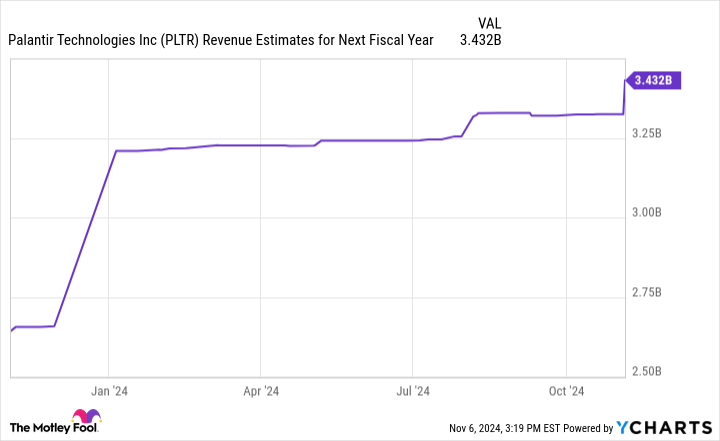Meet the Unstoppable Growth Stock That Just Hit a New All-Time High but Is Still an Unqualified Buy, According to Wall Street
The bull market that has captivated Wall Street is just entering its third year, turning in its best performance since 2011. It pushed the Dow Jones Industrial Average, S&P 500, and Nasdaq Composite to record heights earlier this week.
One of the factors fueling this record run is recent advances in artificial intelligence (AI). The technology, which first burst on the scene in early 2023, is unlike anything that came before. Generative AI can not only streamline processes but also create original text and images, potentially increasing productivity and sending more profits to the bottom line.
Start Your Mornings Smarter! Wake up with Breakfast news in your inbox every market day. Sign Up For Free »
Investors might be surprised to learn that Amazon (NASDAQ: AMZN) has been using earlier forms of AI for decades, which gave the company a running start when AI came calling early last year. This history of deploying AI helped Amazon fashion the AI solutions it offers to customers. Add to that the company’s dominant positions in cloud computing and digital retail and its strong position in digital advertising, and you have a company that’s a quadruple threat in the tech industry.
Strong growth across its quartet of businesses has driven the stock to record heights, and according to Wall Street, this might just be the beginning.
There’s no denying the challenges of the past several years, marked by macroeconomic headwinds and decades-high inflation. Those conditions have recently given way to a robust recovery, with consumer sentiment hitting its highest point in more than six months. Additionally, the Federal Reserve Bank just announced the second in its ongoing series of interest rate cuts as the specter of inflation fades.
The rebound in the economy has helped drive improving results for Amazon. For the third quarter, revenue of $159 billion rose 11% year over year, while diluted earnings per share (EPS) of $1.43 jumped 52%.
Improvements from each of the company’s major operating segments helped drive the results. Online retail sales in North America increased 9%, while international sales climbed 12%. The reacceleration of Amazon Web Services (AWS) — the company’s cloud infrastructure service — continues, jumping 19%, its highest rate of growth since late 2022. Amazon also continued to make inroads in digital advertising, one of its fastest-growing segments, which increased 19%.
Amazon is unmatched in the online retail business it pioneered. The company captured 38% of U.S. e-commerce sales in 2023, more than its next 15 largest competitors combined, according to data provided by eMarketer. The company’s leadership is anticipated to continue this year, as Amazon is expected to account for 40% of online sales in the U.S. in 2024.
This Unstoppable Telecom Giant Returned More Capital to Shareholders Than Both AT&T and Verizon Over the Past Year, and It Just Raised Its Dividend 35%
One thing that attracts many investors to telecom stocks are the great dividend yields offered by many companies in the industry. Subscription revenue and long-term contracts are a great recipe for predictable free cash flow. And many of the biggest companies in the industry are happy to return that cash to shareholders.
Verizon Communications (NYSE: VZ), for example, paid out $11.2 billion to shareholders over the last 12 months. The stock currently boasts an attractive dividend yield of 6.6%. AT&T (NYSE: T) has slimmed down over the past few years, now focusing exclusively on its telecom business. It sports a 5% dividend yield, paying out $8.2 billion to shareholders over the past year.
Start Your Mornings Smarter! Wake up with Breakfast news in your inbox every market day. Sign Up For Free »
But one of its biggest competitors has returned even more cash to shareholders. T-Mobile (NASDAQ: TMUS) returned a total of $11.8 billion over the past year. The only caveat is this telecom giant is primarily using share repurchases in its capital-return program, something that’s practically non-existent recently at Verizon and AT&T.
Over time, however, T-Mobile could shift that focus to dividends. In fact, management just announced a 35% increase to its dividend payout, bringing its yield to a healthy 1.6%. T-Mobile’s massive capital-return program could prove even better for shareholders than big cash dividends from its competition.
There are really only two ways for management to return excess cash to shareholders: share repurchases and dividends.
Dividends are straightforward: The company pays owners a set amount of cash per share, usually on a regular cadence like every quarter. While management isn’t obligated to pay out the same amount every period, dividends are generally very sticky. Once a company starts paying a certain amount, they try to keep paying at least that much. Often, a company will raise its dividend over time. Verizon has increased its dividend annually for 18 straight years.
Share repurchases, on the other hand, are an indirect way to return cash to shareholders. Instead of distributing cash, management uses it to buy shares of the stock in private deals or on the open market. The shareholders end up with a greater share of the business.
Another way to think of it is shareholders receive equity in the business instead of cash. It’s almost the same as a shareholder who automatically reinvests dividends into the stock. However, there’s much less of a tax drag on the transaction. Share repurchases incur a 1% tax (paid by the business); qualified dividends are taxed at the long-term capital gains tax rate (paid by the shareholder).
Money market account rates today, November 10, 2024 (best account provides 5.00% APY)
Between March 2022 and July 2023, the Federal Reserve raised its benchmark rate 11 times. As a result, money market account (MMA) interest rates rose sharply.
However, the Fed slashed the federal funds rate by 50 basis points in September. So deposit rates — including money market account rates — have started falling. It’s more important than ever to compare MMA rates and ensure you earn as much as possible on your balance.
The national average money market account rate stands at 0.64%, according to the FDIC. This might not seem like much, but consider that just two years ago, it was just 0.23%, reflecting a sharp rise in a short period of time.
This is largely due to monetary policy decisions by the Fed, which began raising its benchmark rate in March 2022 to combat skyrocketing inflation. In fact, the Fed increased rates 11 times. But it finally cut its benchmark rate in September, causing deposit account rates to start dropping
Even so, some of the top accounts are currently offering upwards of 5% APY. Since these rates may not be around much longer, consider opening a money market account now to take advantage of today’s high rates.
Here’s a look at some of the top MMA rates available today:
See our picks for the 10 best money market accounts available today>>
Additionally, the table below features some of the best savings and money market account rates available today from our verified partners.
The amount of interest you can earn from a money market account depends on the annual percentage rate (APY). This is a measure of your total earnings after one year when considering the base interest rate and how often interest compounds (money market account interest typically compounds daily).
Say you put $1,000 in an MMA at the average interest rate of 0.64% with daily compounding. At the end of one year, your balance would grow to $1,006.42 — your initial $1,000 deposit, plus just $6.42 in interest.
Now let’s say you choose a high-yield money market account that offers 5% APY instead. In this case, your balance would grow to $1,051.27 over the same period, which includes $51.27 in interest.
The more you deposit in a money market account, the more you stand to earn. If we took our same example of a money market account at 5% APY, but deposit $10,000, your total balance after one year would be $10,512.67, meaning you’d earn $512.67 in interest.
FTX Sues Scaramucci to Recoup Money for Creditors
(Bloomberg) — FTX filed a lawsuit against Anthony Scaramucci and his hedge fund SkyBridge Capital as part of a broader effort to claw back money for creditors of the bankrupt company.
Most Read from Bloomberg
The lawsuit against the former White House communications director is one of 23 filed in the bankruptcy court of Delaware on Friday. Defendants also include digital-asset exchange Crypto.com and political groups such as the Mark Zuckerberg-founded FWD.US, according to court documents.
FTX alleges that during the crypto winter of 2022, founder Sam Bankman-Fried engaged “in a campaign of influence-buying throughout the year and making lavish and showy ‘investments’.”
“One connection that Bankman-Fried poured significant time and money into” was Scaramucci, for his “established financial, political, and social” network, according to the filing.
FTX is now going after these investments as it claims they “conveyed little to no benefit,” and “instead served only to prop up Bankman-Fried’s standing in the worlds of politics and traditional finance.”
The bankrupt crypto firm alleges that Bankman-Fried invested $67 million into various SkyBridge endeavors in 2022 as Scaramucci had been “seeking a bailout.” SkyBridge’s assets under management had fallen from a 2015 high of $9 billion to $2.2 billion, according to the filing. FTX is now seeking to recover more than $100 million in damages.
A representative for Scaramucci declined to comment.
In September 2022, Bankman-Fried and Scaramucci announced that the venture arm of FTX would acquire a 30% stake in SkyBridge. Financial terms were not disclosed at the time. Scaramucci said then that the investment reflected that he was “thinking about the next decade of SkyBridge.”
Within a few months, FTX had filed for bankruptcy and Bankman-Fried had been arrested in the Bahamas on fraud charges.
The case is FTX Trad. Ltd., Bankr. D. Del., No. 22-11068, suit 11/8/24.
(Updates with damages in sixth paragraph, earlier version corrected other parties sued by FTX in second paragraph.)
Most Read from Bloomberg Businessweek
©2024 Bloomberg L.P.
3 Top Artificial Intelligence Stocks to Buy in November
Nearly every technology company touts its artificial intelligence credentials these days. I don’t blame them, considering AI is a valuable addition to many software and services.
But just because tons of companies are quickly integrating AI into their offerings, it doesn’t mean they’re top AI stocks. Instead, you should look for leaders who are knee-deep in this segment and setting the pace in the AI race. Here are three top AI stocks leading the pack that are worth buying right now.
Start Your Mornings Smarter! Wake up with Breakfast news in your inbox every market day. Sign Up For Free »
Palantir Technologies (NYSE: PLTR) was in the business of helping organizations sort data before AI became commonplace. For years, it focused on using artificial intelligence to help the government parse through gobs of data, but it has since expanded into the commercial market.
Its early lead in this space is paying off. The company just reported its third-quarter results (which ended Sept. 30), in which revenue rose 30% from the year-ago quarter to $726 million and adjusted earnings per share spiked 43% to $0.10.
U.S. commercial revenue, a fast-growing part of Palantir’s business, increased sales by 54% to $179 million and accounted for about one-quarter of the company’s total revenue in the quarter. Part of that growth comes from Palantir’s impressive customer growth, which was up 39% in the quarter amid 104 customer deals that were worth $1 million or more.
If I have one hesitation with Palantir, it’s the company’s sky-high valuation. Palantir’s shares have forward price-to-earnings of 101 right now. That’s expensive by any measure.
However, the company is clearly making the right moves in the AI race and is also profitable, not to mention having $4.6 billion in cash and cash equivalents. With its customers knocking down its doors for its tech, and sales and earnings growing at a healthy clip, Palantir likely still has more room to run.
Nvidia (NASDAQ: NVDA) is one of the obvious choices when it comes to top AI stocks. For years, the company has dominated the graphics processing unit (GPU) market when they were mainly used for gaming, but now its GPUs are far and away the leading choice to power AI data centers as well.
The most recent estimates give Nvidia’s chips between 70% to 95% of the AI chip market, and its latest product lineup — including its popular H200 processor — will likely keep the company ahead of the competition for some time.
You might be wondering if demand for AI chips could be high enough to fuel sustained growth for Nvidia, and to that, I’d say that both Nvidia’s CEO Jensen Huang and Goldman Sachs think $1 trillion in AI spending will occur over the next few years, most of which will be funneled into data centers.
Empty Nesters Beware: Avoid This Costly Retirement Pitfall
Saving for retirement is a lifelong undertaking. It involves keeping your retirement goals in mind as you have children, get different jobs and move from place to place. However, a recent study from the Center for Retirement Research at Boston College shows that many parents may not be keeping up with their retirement savings goals after their children leave home. Parents who consistently fall short of retirement savings goals may be unable to cover regular expenses. The study suggests a number of reasons why empty-nester parents neglect retirement savings, including the fact that such parents tend to work slightly less. Because retirement saving is a marathon, not a sprint, it’s important to make sure you’re staying on top of your retirement savings goals even after your children have left home. A financial advisor can help keep you stay on track.
Empty Nesters Are Falling Behind: Report Findings
The report done by the Center for Retirement Research at Boston College examined how empty nester parents adjust their savings, consumption and earnings after children leave the house. The report aims to reconcile the fact that some studies have shown that empty nester parents reduce consumption and increase savings while others have shown that savings don’t increase.
The authors of the study offered up three possible explanations to reconcile these inconsistencies:
-
Empty nester parents could pay down debts after children leave home
-
Parents could continue to provide financial support to children after they’ve left
-
Empty nesters tend to adjust their earnings and work hours after children leave home
Surprisingly, the study found that overall, parents don’t tend to pay down debts and parents typically don’t continue to provide meaningful financial support to their children after they’ve left home. What they did find was significant evidence to show that empty-nester parents reduce their working hours and earn about $2,000 less per year after children no longer live with them.
This study also found that consumption, relative to income, decreased by about 6% for empty-nester parents. However, net worth remained unchanged, leaving a question mark as to why such parents aren’t saving more. Consider using this free tool to match with a fiduciary financial advisor who can help you evaluate your financial circumstances and build an appropriate strategy for your goals.
Why Do Empty Nesters Save Less For Retirement?
There are a number of possible explanations when it comes to figuring out why empty-nester parents don’t seem to be saving as much as they should. A consistent finding of the study was that empty-nester parents tend to work less and therefore earn less. Despite the fact that consumption is also lower, a change in nominal income has the potential to throw off savings targets and goals. If someone who normally contributes $2,000 per year to retirement begins earning $2,000 less annually, it’s easy to see how he may forgo saving that $2,000 altogether, even if he’s consuming less overall.
Can I Keep All of My $2,700 Monthly Social Security Benefit, or Will Taxes Cut In?
SmartAsset and Yahoo Finance LLC may earn commission or revenue through links in the content below.
Social Security plays a critical role in the retirement plans of millions of Americans, but how these benefits are taxed is sometimes overlooked. If you collect $2,700 per month in Social Security benefits, your check is well above the average retirement benefit of approximately $1,800 per month and it could mean that you’ll owe taxes on this money. However, there are ways to potentially reduce your tax liability. Consider working with a financial advisor to create a comprehensive financial plan for retirement that accounts for your Social Security benefits and tax situation.
Social Security benefit taxes are calculated based on “combined income.” As your combined income climbs, you’ll potentially owe taxes on a larger percentage of your benefits. Here’s how combined income gets calculated:
So, for example, say that you withdraw $50,000 from your 401(k) and collect $40,000 in annual Social Security benefits. Your combined income would be $70,000 ($50,000 + $40,000/2).
From there, the IRS uses the following income tiers to tax the benefits of people who file their taxes as individuals:
-
Combined income below 25,000: Benefits are not taxable
-
Combined income between $25,000 and $34,000: Up to 50% of benefits are taxable
-
Combined income above $34,000: Up to 85% of benefits are taxable
If you file a joint return with your spouse, the following income tiers will determine the taxability of your Social Security:
-
Combined income below $32,000: Benefits are not taxables
-
Combined income between $32,000 and $44,000: Up to 50% of benefits are taxable
-
Combined income above $44,000: Up to 85% of benefits are taxable
Note that these are not the tax rates. Rather, this means that up to 50% or up to 85% of your Social Security benefits are subject to your ordinary income tax rates. But if you need help assessing your tax liability, consider speaking with a financial advisor with tax expertise.
As we mentioned above, the more combined income you have, the more of your benefits can potentially be taxed. If you collect $2,700 per month, that’s $32,400 per year in Social Security benefits, which gives you a starting combined income of $16,200 ($32,400/2). If Social Security were your sole source of income, you wouldn’t owe any taxes on your benefits.
From there, taxes will apply depending on your other sources of income. For example, say that you withdraw $50,000 from your 401(k). That would make your combined income $66,200 (50,000+16,200), meaning up to 85% of your benefits – $27,540 – would be taxable.
Missed Out on Nvidia? Buy These 3 AI Stocks.
Perhaps no stock benefited more from the boom in artificial intelligence (AI) than Nvidia. Its dominance in the AI chip market redefined the direction of the company and much of the industry at large.
Unfortunately, many AI investors missed out on Nvidia’s boom. The good news is that most analysts expect AI-driven gains in the technology market for years to come.
Start Your Mornings Smarter! Wake up with Breakfast news in your inbox every market day. Sign Up For Free »
To this end, three Motley Fool contributors have ideas on where investors should look next for these gains: Palantir Technologies (NYSE: PLTR), Meta Platforms (NASDAQ: META), and Tesla (NASDAQ: TSLA).
Jake Lerch (Palantir Technologies): I’ve been bullish on Palantir for a while, and the company’s most recent earnings report gives me no reason to change my mind. In short, it is executing at a level that should make every investor sit up and take notice.
The company, which operates an AI-driven platform for government and commercial clients, sits at the forefront of the AI revolution. It helps organizations implement large language models for highly specific purposes.
For example, the company has helped with jobs as diverse as speeding up the underwriting process for insurance companies and managing battlefield assets for the military.
The proof of Palantir’s success can be seen in its results. In the most recent quarter (the three months ending on Sept. 30), the company achieved the following:
-
U.S. revenue increased 44% to $499 million.
-
Total revenue grew 30% to $726 million.
-
Adjusted operating margin was 38%.
-
Customer count grew 39%.
Analysts expect that growth to continue. We’re just getting started in the AI revolution, and many organizations have yet to fully explore how they can drive efficiencies with it.
Consensus estimates suggest that Palantir’s revenue will increase 23% in 2025 to roughly $3.4 billion. Those estimates have been rising since the company’s excellent earnings report, and I believe it’s likely that they continue to increase as we head into 2025.
In short, Palantir is my top choice for an AI company to own in 2025.
Justin Pope (Meta Platforms): There hasn’t been anything wrong with Meta Platforms’ stock, which cruised more than 380% higher since the start of last year. Yet, I think there is still a lot of juice to squeeze here.
First, the stock remains a bargain for the growth you’re getting. Meta trades at a price-to-earnings ratio (P/E) of 25. And analysts estimate the company will grow earnings by an average of 20% annually over the next three to five years.
Inflation and retail sales data greet a roaring stock market rally: What to know this week
All three major indexes pressed to record highs after Donald Trump won the 2024 presidential election.
For the week, the S&P 500 (^GSPC) and the Dow Jones Industrial Average (^DJI) rose more than 4.5%, while the Nasdaq Composite (^IXIC) rose nearly 6%.
In the week ahead, a fresh reading on inflation and retail sales will lead the economic calendar.
In corporate news, quarterly results from Home Depot (HD), Cisco (CSCO), and Disney (DIS) will highlight another week of earnings reports.
In a widely anticipated move, the Federal Reserve cut interest rates by 25 basis points last Thursday. In a press conference following the announcement, Fed Chair Jerome Powell declined to comment on the central bank’s plans for future rate cuts.
“We don’t think it’s a good time to be doing a lot of forward guidance,” Powell said. He later noted that Fed officials will need to gauge the economic data released between now and December before knowing if the central bank will cut interest rates again this year.
The first data the Fed will consider ahead of its next meeting will come out on Wednesday with the release of the October Consumer Price Index (CPI). Wall Street economists expect headline inflation rose just 2.6% annually in October, an increase from the 2.4% rise in September. Prices are set to rise 0.2% on a month-over-month basis, per economist projections, in line with the increase seen in September.
On a “core” basis, which strips out food and energy prices, CPI is forecast to have risen 3.3% over last year in October, unchanged from September’s increase. Monthly core price increases are expected to clock in at 0.3%, also in line with the September gain.
“The October CPI report will likely support the notion that the last mile of inflation’s journey back to target will be the hardest,” Wells Fargo’s economics team led by Jay Bryson wrote in a weekly note to clients on Friday.
The final monthly retail sales report before the start of the holiday shopping season is set for release on Thursday. Economists estimate retail sales increased 0.3% over the prior month during October. The control group of retail sales — which excludes several volatile categories like gasoline and feeds directly into gross domestic product (GDP) — is also expected to have risen by 0.3%.
Entering the release, several trackers point to the fourth quarter being off to a solid start for economic growth. The Atlanta Fed GDPNow tracker currently projects the US economy growing at 2.5%.
Wall Street Giants Split Time Between Trillion-Dollar Gulf Hubs
(Bloomberg) — BlackRock Inc.’s Larry Fink was among headliners at Saudi Arabia’s annual Davos-style investment confab in October. Days later, he popped up on a social media post from Abu Dhabi’s $1.5 trillion man, Sheikh Tahnoon bin Zayed Al Nahyan.
Most Read from Bloomberg
The $11.5 trillion asset manager Fink runs recently received approval to set up its regional headquarters in Riyadh. It’s also teaming up with the Abu Dhabi royal on one of the largest efforts to date to bankroll the build-out of data warehouses and energy infrastructure.
The biggest firms on Wall Street operate across geographies and top executives often fly to multiple countries while visiting a region. But Riyadh and Abu Dhabi, which are competing to be the Middle East’s main business hub, offer unique opportunities: The cities control over $1 trillion in sovereign wealth each, making them among the biggest pools of capital in the world.
Sheikh Tahnoon — one of Abu Dhabi’s two deputy rulers, the United Arab Emirates’ national security adviser and brother to its president — had conversations with many executives who also spoke at the FII, according to posts on the royal’s X profile.
That list included Morgan Stanley Chief Executive Officer Ted Pick, Blackstone Inc.’s Steve Schwarzman and Ruth Porat of Alphabet Inc., which is partnering with Saudi Arabia on an artificial intelligence hub. Meanwhile, Goldman Sachs Group Inc. CEO David Solomon also dropped by in Abu Dhabi shortly after his firm announced its new Riyadh office, according to a person familiar with the matter.
The two cities have rolled out a series of initiatives in their quest for greater global relevance. Riyadh is asking international firms to boost their local presence, or risk losing business. That’s prompted the likes of General Atlantic and Goldman to beef up their operations in the kingdom.
Some others have been reluctant about making Riyadh their main hub because their employees prefer the lifestyle in the UAE. To further sweeten the deal, Abu Dhabi has also rolled out a series of perks, including a lifestyle-support program for incoming financiers.
But many firms looking to raise cash or plug into dealmaking driven by ambitious diversification programs are trying to keep a foot in both camps.
BlackRock, for instance, said its new Riyadh base will help the firm expand operations across the Middle East and not just in the kingdom. Goldman continues to have a significant presence in both Dubai and Abu Dhabi, and Barclays Plc, which is considering re-entering Saudi Arabia after a decade, said it intends to grow its team in the UAE as well.










